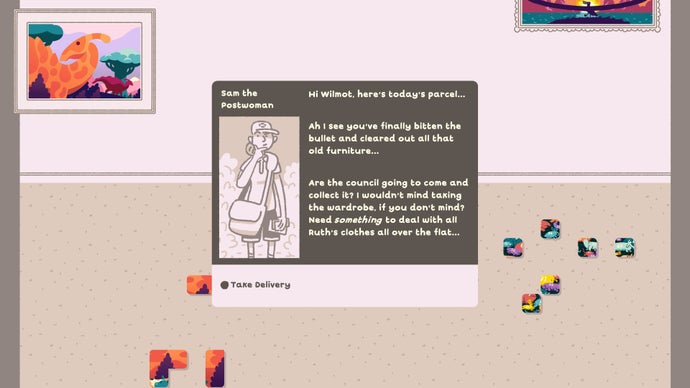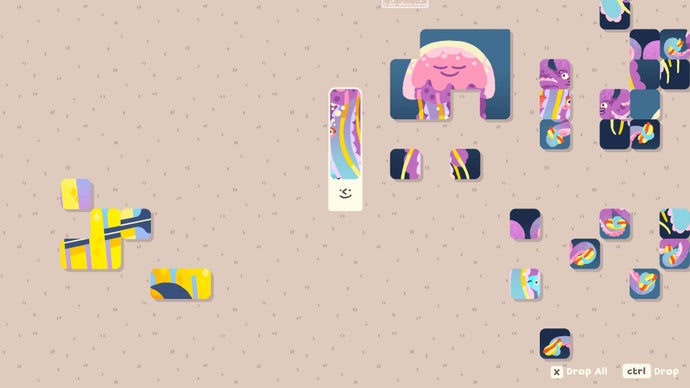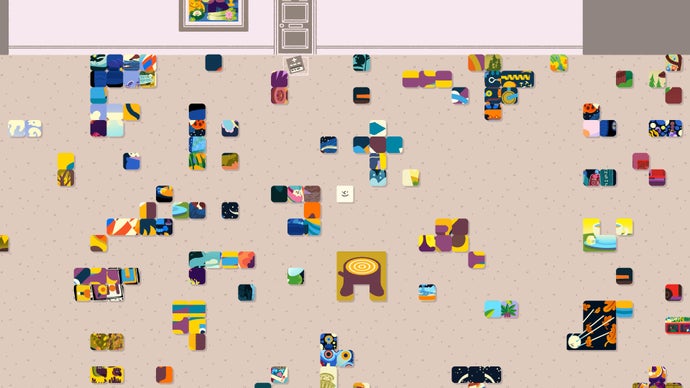Wilmot’s gentle and relaxing jigsaw puzzles won’t tax you in the slightest, but this warm bubble bath of a game is very soothing, and it weaves a surprising tale of companionship and found friends around the edges.
You’ve got to feel for Sam the postwoman. Every day she brings Wilmot the next instalment of his puzzle club subscription, and every day she tries to engage him in conversation – about the weather, why there are five cars in the neighbour’s driveway, her sister Ruth moving in, her next walking holiday… Heck, she even invites Wilmot to go on holiday with her at one point. A bit forward, if you ask me, but who am I to stand in the way of human and sentient white cube relationships?
Wilmot, though, is having none of it. While it’s unclear what prompted him to leave the warehouse where he made his name back in 2019 (was he let go due to operational cutbacks? Or did he just spend too much time making aesthetically pleasing storage wings? Alas, its breezy and earnest script never delves into such questions), Wilmot’s latest occupation is ‘housebound puzzle enthusiast-cum-home decorator’. Instead of using his right-angled good looks to sort and shuffle abstract materials onto conveyor belts, he now uses those same muscular shoulder button squeezes to carry and rotate square picture pieces and – once they flash and emit a soft chirrup indicating what you’re holding is a match to the one you’ve sidled up next to – click them together to make colourful works of art to hang around his home.
It’s a blissful existence, really, but it really is all puzzles all the time with this guy, to the point where you almost think Wilmot might be a bit of a turd behind that constant happy grin of his. For example, he does, on occasion, get a rare dialogue prompt to ask after Sam’s sister, or later on how Sam’s own attempt at puzzle club is going (again with the puzzles), but most of your interactions with this ever-cheerful post lady boil down to ‘take delivery, shut door, get back to making pretty pictures out of your latest parcel’. I really do admire Sam’s tenacity on this front, because bless her, she’s secretly the heart and soul this gentle little puzzle game, providing a much-needed human touch to Wilmot’s otherwise quite abstract picture building, and rooting each delivery in the warm, friendly embrace of having a hobby you can (sort of) share with other people.

Wilmot himself may be seemingly uninterested in the comings and goings of Sam’s daily chitchat, but her presence here is an important one. Firstly, she’s the Bringer of Puzzles, doling out her daily deliveries to keep you topped up with increasingly large packets of pictures to solve. One parcel doesn’t always equate to one complete puzzle in Wilmot Works It Out, and you’ll frequently have two or three puzzles on the go at once as more packages come in. This not only helps to keep things fresh, but there’s a genuine, low-key thrill at finally spotting the last few pieces you need to finish off another painting you’ve been working on for several in-game ‘days’ and putting it up on your wall (indeed, Sam’s forceful door knocks are the only real indicator that time even exists outside the four, windowless walls of Wilmot’s hallway, that’s how all-consuming his puzzle obsession is).
Portioning out pieces in this drip-feed fashion also allows developer Hollow Pond to pull a couple of cheeky fast ones on you every now and again, mixing in pieces that look just similar enough to pass as possible stablemates when they’re all scattered over your floor, but which actually belong to different puzzles entirely. You’ll start grouping them together to get your bearings, but then you realise, nope, this yellow dotted background forms a picture of some smiling red cherries, while this dotted yellow background belongs to a bunch of top-down red chess pieces, for example. It’s hardly rocket science, and most of the time you’ll be able to tell straight away which pieces go together based on their colour schemes and patterns. But it’s receiving them in batches like this that creates this light layer of friction, and prevents it from being a complete and obvious pushover.


What’s more, Sam’s deliveries are always timed to conveniently coincide with whenever you run out of viable puzzle pieces to click together. She’s the Gatekeeper of Puzzles, in a way, and she sets the pace for your mural meanderings so you always know when it’s time to move on, or when there’s still a few pieces left that can be pushed side by side. I’ll admit I had a few moments where I thought I’d done everything possible with the pieces available to me, but when Sam didn’t arrive, it made me look just a little bit closer at what was in front of me, and led to some genuine revelations that I would have probably glossed over had the deliveries not been staggered like this.

More than anything, though, Sam is the beating Heart of Puzzles in Wilmot Works It Out, sending you puzzles of her walking in the Alps when she’s on holiday, joining up as a puzzle club member herself because she can see how much joy it brings you, and generally just being a lovely presence to be around. For example, when she does go travelling and her taciturn male sub turns up in her stead for a few days, I did start to miss her garrulous updates quite a bit, and was surprisingly relieved when she returned. Indeed, Wilmot’s puzzle obsession paints quite a lonely little existence for this perpetually smiling white square, and Sam’s temperate pleas for him to just get out of the house for once all build to an unexpectedly moving final puzzle.
Sam’s presence is also missed when you turn your attention to the game’s Marathon Mode, which gives you an even larger floor space to tip your puzzle pieces onto, as well as completely randomised packages where there’s no rhyme or reason to which pieces you receive. This mode only unlocks once you’ve completed the main story, but when it recycles so many pictures you’ve just spent the last six hours putting together, it does suffer a bit from being so overly familiar. I found myself able to simply remember which pieces went together, rather than making any properly new mental connections like I did the first time round. But my biggest bugbear is how these Marathon parcels are simply parped through your letterbox – no knock, no jolly postie – with another one arriving as soon as you’ve lifted the last one off the doormat. I get that endless modes are meant to be smooth and distraction-free, but it did also feel a lot colder and more clinical as a result, highlighting just what a difference Sam’s sunny disposition made back in the main part of the game.

Generally, though, Wilmot Works It Out is a very snug and pleasant experience. It is entirely without pressure or consequence, and it won’t make you feel particularly clever or smart like other puzzle games can. But it does succeed in making you feel warm and fuzzy for six hours, where hitting pause is rebranded as a ‘tea break’, and where each of its so-called puzzle ‘seasons’ can be completed in as little as 30-40 minutes, giving you a decent, bite-sized chunk of game to noodle about with while still feeling like you’re accomplishing something. Every painting, created by frequent Hollow Ponds collaborator Richard Hogg, is a weird and whimsical delight, and watching owl faces, gurning flurries of flat fish, maps, knots, sleepover parties, gizmo shelves and more all start to take shape square by square never fails to be good wholesome fun, especially when they’re set to the calming, muzak thrums of Eli Rainsberry’s musical score. But the real star here isn’t so much Wilmot as it is Sam, and I hope we get to see more of her natterings in whatever comes next for this mysterious little cube dude.
A copy of Wilmot Works It Out was provided for review by Finji.
